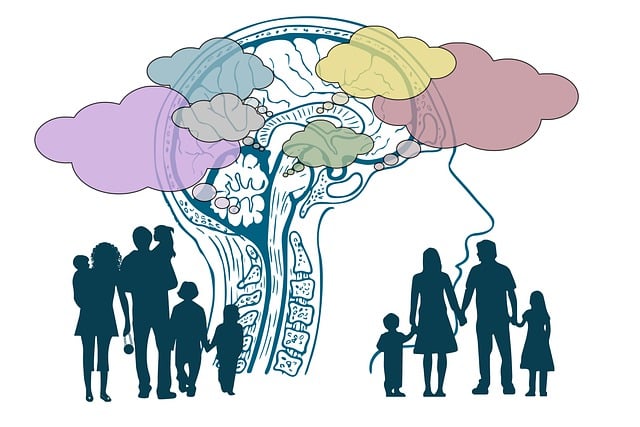Maintaining healthy co-parenting boundaries is crucial for separated or divorced parents to foster trust and collaboration. These boundaries define roles, responsibilities, and expectations, ensuring respect for each other's authority and decisions regarding their shared children. Key aspects include open communication through active listening and respectful dialogue, clear role definitions to reduce confusion and foster respect, and establishing personal space, preferences, and joint parenting rules to minimize conflicts and strengthen the parent-child bond. Ultimately, these boundaries create a stable environment that benefits both parents and children.
Fostering trust and collaboration between co-parents is paramount for creating a stable and nurturing environment for children. In this article, we explore essential strategies to achieve healthy co-parenting boundaries, including effective communication, clear role definition, and the cultivation of a positive co-parenting dynamic. By understanding the importance of these boundaries, parents can navigate their relationship more harmoniously, ensuring their children thrive in a secure and loving home. Discover practical tips for each area to enhance your co-parenting journey.
Understanding the Importance of Healthy Co-Parenting Boundaries
Maintaining healthy co-parenting boundaries is a cornerstone of fostering trust and collaboration between separated or divorced parents. These boundaries establish clear roles, responsibilities, and expectations, ensuring each parent respects the other’s authority and decisions regarding their shared child(ren). By defining these limits, co-parents can create a stable environment for their children, minimizing confusion and conflict.
Healthy co-parenting boundaries promote open communication and mutual respect. They encourage parents to discuss important issues together, make joint decisions when possible, and support each other’s efforts in raising the children. This collaborative approach not only benefits the parents’ relationship but also positively impacts the children’s well-being, providing them with a sense of security and stability.
Communicating Openly and Respectfully
Open and respectful communication is a cornerstone of successful co-parenting. Establishing clear, consistent dialogue fosters trust and strengthens the bond between parents, ensuring a stable environment for the children. It involves active listening, where each parent feels heard and understood, and sharing thoughts, feelings, and concerns without judgment. Creating a safe space for honest conversations, even when disagreements arise, is essential for maintaining healthy co-parenting boundaries.
Respectful communication respects individual perspectives, prioritizes the children’s best interests, and encourages collaborative problem-solving. By fostering an atmosphere of mutual understanding, parents can navigate complexities more harmoniously, ensuring their cooperation enhances the overall well-being of their family unit.
Establishing Clear Roles and Responsibilities
Establishing clear roles and responsibilities is a cornerstone of healthy co-parenting boundaries. When both parents have defined tasks and expectations, it reduces confusion and conflict. This clarity allows each parent to focus on their unique contributions, whether it’s handling school pick-ups, managing finances related to the children, or coordinating extracurricular activities. By setting these boundaries, co-parents can ensure a more harmonious sharing of responsibilities, fostering an environment where both feel respected and valued.
Defining roles also helps in avoiding overlaps and gaps in care. It prevents one parent from taking on too much, leading to burnout, while ensuring that no crucial tasks are overlooked. Regular communication is vital to reassess and adjust these roles as the children grow and the parents’ circumstances change, maintaining a dynamic yet structured approach to co-parenting.
Nurturing a Positive Co-Parenting Environment
Creating a positive co-parenting environment is essential for fostering trust and collaboration between separated or divorced parents. The first step involves establishing clear and healthy boundaries. This means defining personal space, communication preferences, and joint parenting rules that respect each parent’s needs and allow for open dialogue. For instance, setting specific times for conversations or meetings can help avoid constant connectivity and encourage focused interactions.
Boundaries provide a structured framework that enables co-parents to navigate their roles effectively while minimizing conflicts. Additionally, nurturing this environment requires active listening and empathy. Both parents should strive to understand each other’s perspectives, acknowledge their individual contributions to child-rearing, and approach decisions collaboratively rather than competitively. This mutual respect and acknowledgment strengthen the parental bond, creating a secure foundation for the children involved.
Fostering trust and collaboration between co-parents is an essential aspect of navigating the challenges of shared custody. By implementing clear boundaries, open communication, defined roles, and a positive environment, parents can create a harmonious co-parenting experience that benefits their children. These strategies promote stability and ensure a nurturing setting for all involved, ultimately strengthening the family unit. Understanding and prioritizing healthy co-parenting boundaries is a game-changer in creating a supportive and loving home environment.
